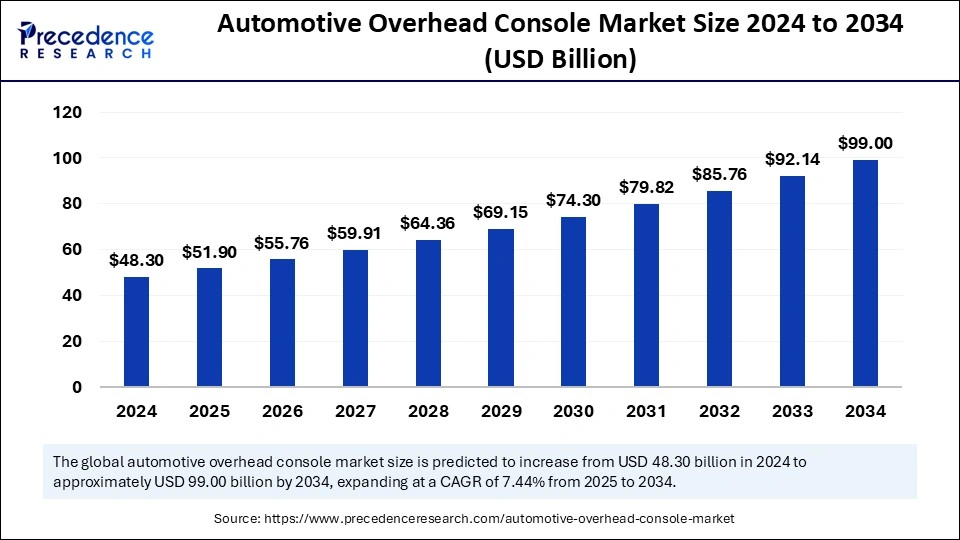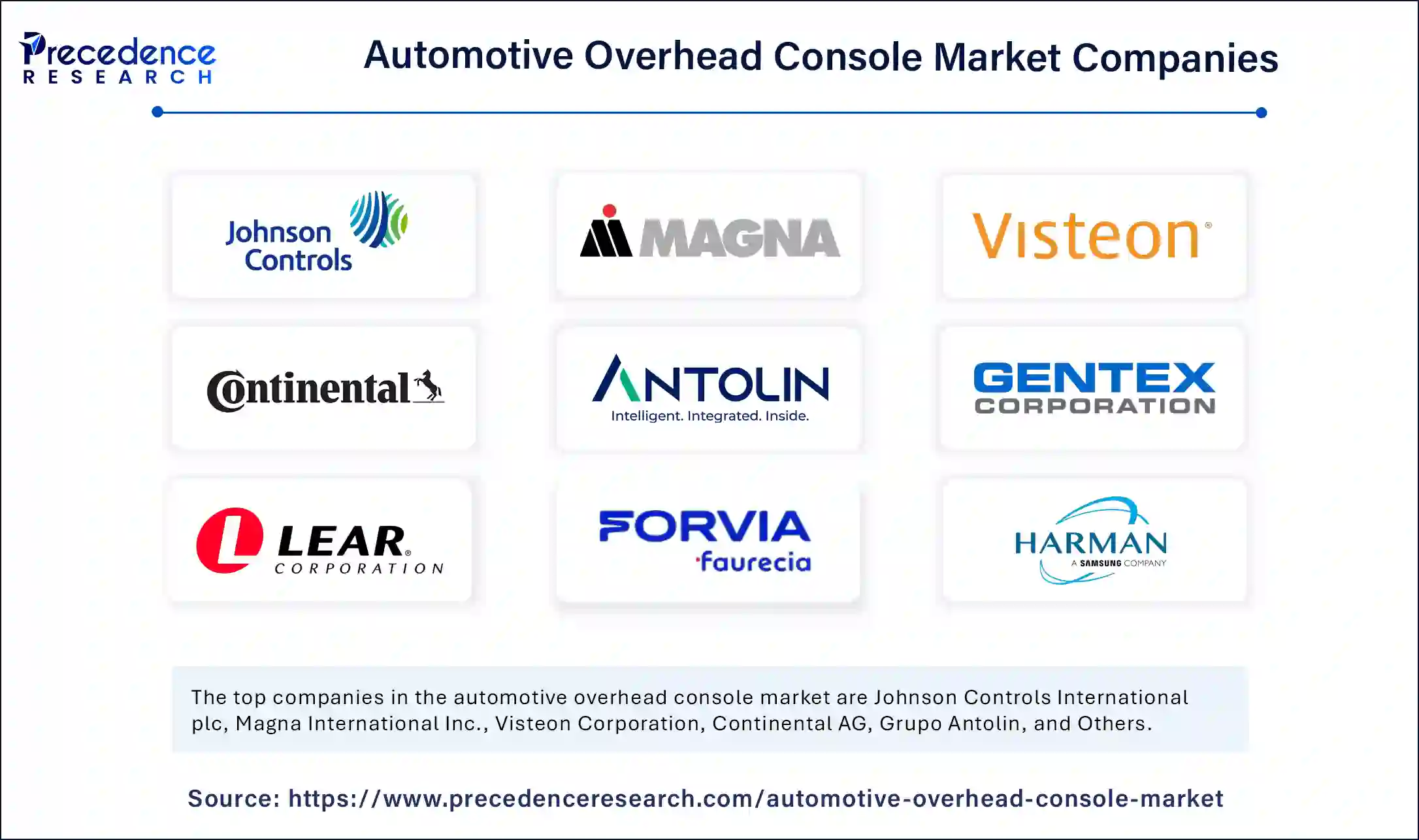The global automotive overhead console market size accounted for USD 51.90 billion in 2025 and is predicted to be worth around USD 99.00 billion by 2034, at a CAGR of 7.44% from 2025 to 2034.

The automotive overhead console, once a humble housing for dome lights and a sunglass holder, has evolved into a sophisticated nerve center within the modern vehicle. Driven by burgeoning consumer demand for advanced features, enhanced connectivity, and personalized in-car experiences, the global automotive overhead console market is witnessing significant growth and is poised for a transformative future.
Table of Contents
ToggleKey Drivers Propelling the Market
Several factors are fueling this market expansion:
- Rising Demand for Advanced Features: Consumers are increasingly prioritizing vehicles equipped with cutting-edge functionalities. Overhead consoles are becoming central to integrating features like advanced lighting controls (including ambient lighting and color temperature control), sophisticated infotainment systems, connectivity modules (Bluetooth, Wi-Fi), and driver assistance features.
- Growth of Connected and Autonomous Vehicles: As vehicles become more connected and autonomous, the overhead console plays a crucial role in housing the necessary sensors, control units, and communication modules for telematics, in-cabin monitoring systems, and future autonomous driving controls. AI integration is also driving innovations in human-machine interactions.
- Emphasis on Interior Aesthetics and Convenience: Modern automotive design places a strong emphasis on sleek, ergonomic, and aesthetically pleasing interiors. Overhead consoles contribute significantly to this by offering integrated, streamlined designs that enhance the overall cabin ambiance and provide convenient access to controls and storage.
- Increasing Adoption of Electric Vehicles (EVs): The EV revolution is a major catalyst. Manufacturers are developing lightweight overhead consoles using sustainable materials to enhance energy efficiency in electric vehicles. EVs also offer opportunities for innovative console designs that integrate battery management displays and charging station connectivity.
- Passenger Comfort and Safety: The focus on passenger comfort is driving demand for advanced features, particularly in rear-end consoles, which offer independent control over lighting, temperature, and entertainment. Furthermore, the integration of safety features like eCall systems and airbag controls within the overhead console enhances overall vehicle safety.
- Customization and Personalization: The trend towards personalized vehicle interiors is prompting OEMs to offer modular and customizable overhead console solutions, catering to individual preferences and lifestyles.
Automotive Overhead Console Market Scope
| Report Coverage | Details |
| Market Size by 2034 | USD 99.00 Billion |
| Market Size in 2025 | USD 51.90 Billion |
| Market Size in 2024 | USD 48.30 Billion |
| Market Growth Rate from 2025 to 2034 | CAGR of 7.44% |
| Dominated Region | Asia Pacific |
| Fastest Growing Market | North America |
| Base Year | 2024 |
| Forecast Period | 2025 to 2034 |
| Segments Covered | Vehicle Type, Technology, Type, Sales Channel, Application, and Regions. |
| Regions Covered | North America, Europe, Asia-Pacific, Latin America and Middle East & Africa |
Segmentation and Key Trends
- By Type: While front overhead consoles currently dominate due to their multi-functionality, the rear-end console segment is expected to be the fastest-growing. This is attributed to the increasing focus on passenger comfort and convenience.
- By Technology: Electro-mechanical technology holds a significant share due to its established presence and cost-effectiveness. However, the display technology segment is projected to experience the highest CAGR, driven by the rising demand for interactive touchscreens for infotainment and control. Capacitive technology is also seeing rapid adoption due to declining display prices.
- By Sales Channel: The OEM (Original Equipment Manufacturer) segment leads the market, as factory-installed consoles offer seamless integration and warranty. However, the aftermarket segment is also anticipated to expand rapidly, driven by the demand for upgrades and replacement components.
- By Vehicle Type: Passenger cars currently dominate the market, propelled by high sales volumes and the increasing incorporation of advanced features. The light commercial vehicle (LCV) segment is expected to witness a notable CAGR, as technology integration improves functionality and operational efficiency.
- By Application: Vehicle telematics is a significant application, with overhead consoles serving as a hub for GPS tracking, real-time data, and fleet management systems. Infotainment systems and Human-Machine Interface (HMI) are also key drivers.
Read Also: Intelligent Battery Sensor Market Size to Surpass USD 22.44 Billion by 2034
Regional Dominance
Asia Pacific currently holds the largest market share, driven by robust automotive production, increasing disposable incomes, and a strong preference for advanced in-car technologies in countries like China, India, and Japan. North America is projected to exhibit the fastest growth in the coming years, fueled by the accelerating adoption of electric vehicles and connected car technologies.
Challenges and Opportunities:
While the market is flourishing, challenges such as the fluctuating costs of electronic components and the ongoing semiconductor crisis can impact production. However, these challenges also present opportunities for innovation in material science (e.g., lightweight and sustainable materials) and modular designs that allow for easier upgrades and reduced installation/maintenance costs.
Automotive Overhead Console Market Companies

- Johnson Controls International plc
- Magna International Inc.
- Visteon Corporation
- Continental AG
- Grupo Antolin
- Gentex Corporation
- Lear Corporation
- Faurecia
- Harman International Industries Inc.
- Toyoda Gosei Co. Ltd.
- Others
The Road Ahead:
The automotive overhead console market is a dynamic and evolving landscape. As vehicle technology continues to advance, we can anticipate even more sophisticated and integrated overhead consoles. The future promises consoles that are not just functional but also seamlessly blend with the vehicle’s interior, offering intuitive human-machine interfaces, advanced driver assistance features, and personalized experiences that redefine in-car comfort, convenience, and safety. The continuous integration of AI, augmented reality, and the shift towards fully autonomous vehicles will undoubtedly shape the next generation of automotive overhead consoles, making them an indispensable part of the smart mobility ecosystem.
